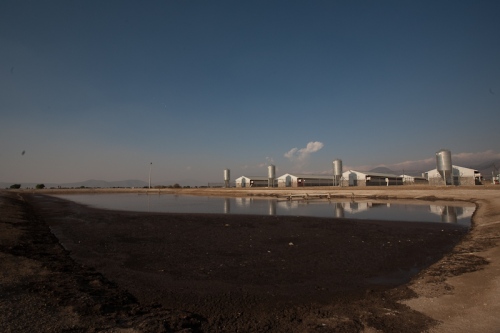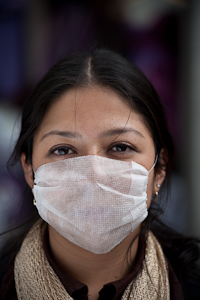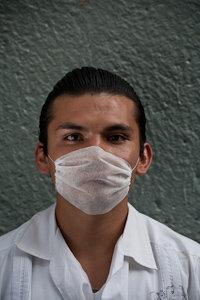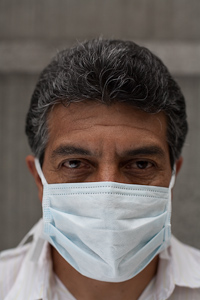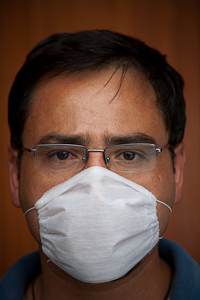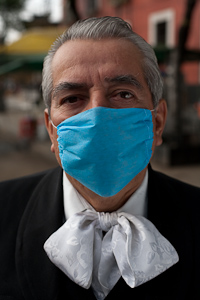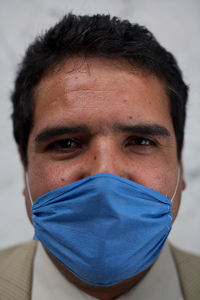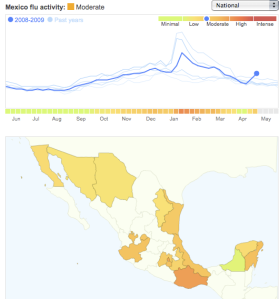
You weren’t supposed to ride the metro, you weren’t supposed to hug or kiss your friends, you weren’t supposed to visit public spaces, and nobody was telling us exactly why. It was day five of the swine flu outbreak, and we had spent the week hanging out at crowded understaffed hospitals, funerals, poor neighborhoods, and vapid press conferences. It was time to get out of the city, before the fear became more dangerous than the disease.
The way out for me and my girlfriend Benedicte was a weekend trip to El Perote, the center of a massive network of Smithfield owned industrial pig farms and the site of the earliest known case of the swine flu. It was clearly the next chapter in the swine flu story.
It felt great to leave the last infinite sprawl of Mexico city for pine covered mountain passes. But as we dropped into the valley where El Perote is located things felt strange. 125 feedlots dotted a barren plain like so many identical towns in the fading light. Smithfield moved in here on the tails of NAFTA, but things really got out of control over the last few years when they realized in Mexico, they could do whatever they wanted and went on a farm building spree. A million pigs now lived here.
Benedicte knew of a local activist in La Gloria, a small town where the first case of swine flu was recorded. In the orange light of his Virgin Mary shrine Guadalupe Gaspar, a middle aged farmer who had recently been jailed for organizing a protest against the feedlots told us about the increasing illness in local communities. Thousands had become sick this year, and dozens had died. This was it’s own story, but the international media only cared about Edgar the first diagnosed case of swine flu in the world. After becoming a minor celebrity he was asked off on a “vacation” by the governor.
The governor had also started paving the road in front of Edgar’s house fixed up the towns run down clinic, started a soup kitchen serving 3 free meals a day, and brought in a gourmet coffee truck to keep the campesinos appeased. But this is how they roll here in Mexico, if you can’t beat them, buy them. Gaspar wasn’t eating at the soup kitchen, he was moire interested in making his case to the news media, about how Smithfield farm’s had destroyed his community.
The only problem was, the media wasn’t interested. In a 24 hour news cycle the cause of something pales besides the next dramatic symptom. Do we care why there is so much breast cancer, do we care why our financial system melted down. No, we care about the victims, and there was no more swine flu victims in La Gloria.
The next day we set out on our own to document the Smithfield presence in the area. We starred out at stagnant ponds of pig excrement and listened to the constant rush of food down metal pipes into the packed warehouses, but we didn’t have much time to enjoy our first look at industrial farming before security detained us, and forced us to follow an angry PR hack who was showing a french journalist their “model farm” before flying him via helicopter to their private lab to “prove” the swine flu didn’t come from his farms. “Look” the PR guy said, rushing us around. “No flies, no smell, everything is fine here.”
Since the beginning of the outbreak Smithfield farms and the Mexican government have sought to turn the world’s eyes away from industrial farming as the cause of the swine flu. Even going so far as to say it was impossible that the swine flu originated in factory farms. Since then scientists have traced the disease to a 1990’s influenza from North Carolina factory farms proving industrial farms breed the disease. The only question that remains is, how did it get from pigs to humans. Smithfield farms has blamed the outbreaks on locals raising pigs for the family. Gasper and a lot of scientists think it is a lot more likely that the strain jumped from the factory farms to local communities.
The next day Gerardo, Gaspar’s son showed us the sites our PR guided tour had forgotten to include.
Driving quickly across farming roads to avoid security, we saw numerous manure ponds with no plastic sheeting stopping the toxic waste from entering the ground, we saw piles of drugs used to treat the sick pigs, some was burnt, some lying in gullies, we saw three acre size ponds of pig shit that had been driven up into the nearby hills and dumped in ravines that turned to streams in the wet season, we saw a well that Smithfield had promised a community who agreed to have a feedlot next door. The community was never given access to the well and was forced to use shallow wells polluted by the feedlot. The last thing we saw was concrete death pits. Concrete rooms in the ground where diseased and dead pigs are dumped and left to rot. Burning them would be too expensive.
Everything was not fine here.
We left soon after, because security was arriving. We had seen enough. Enough to promise each other to never eat industrial grown pork again. And enough to be convinced that the fast and loose way Smithfield farms was operating had created the perfect conditions to create the swine flu, and to pass it to humans.
There is a good chance that the swine flu did not originate at these factory farms, a credible theory places the birth of the disease in Asia. Yet no one can argue that the El Perote industrial farms are a prime suspect. So why is there no international team investigating the farms, why has the Mexican government refused to grant access to an University study on the industrial farms, why does the mainstream media not care about the cause of the disease that has costs the world billions of dollars and helped drive the recession further towards a depression?
And it may be too late to find out the truth. The trail of swine flu antibodies that can prove if the disease had been in a certain human or pig has gone cold and we are left not knowing. Which is right where the Government and Pork lobby seem to want us.
Yet even if there is never any proof found, the lesson was clear to us as we drove back home to Mexico City. The cost of cheap pork is a new breed of mega diseases. Theses diseases will not decimate mankind as the our sensational media likes to imply, but perhaps the Swine Flu offers us all the chance to ask the question, is it worth it, or is their another way.
That was written for Green and Organic Lifestyle Magazine.













